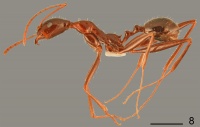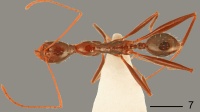Aphaenogaster lykiaensis
| Aphaenogaster lykiaensis | |
|---|---|

| |
| Scientific classification | |
| Kingdom: | Animalia |
| Phylum: | Arthropoda |
| Class: | Insecta |
| Order: | Hymenoptera |
| Family: | Formicidae |
| Subfamily: | Myrmicinae |
| Tribe: | Attini |
| Genus: | Aphaenogaster |
| Species group: | cecconii |
| Species: | A. lykiaensis |
| Binomial name | |
| Aphaenogaster lykiaensis Borowiec & Salata, 2014 | |
The nest entrance was located in a gap in a concrete culvert 2 m across, by a road, at the height of about 1.70 m above the ground. Foraging workers were observed mainly within 1 m from the entrance to the nest, but two workers were caught 2 m from the nest, low above the ground in a tight dark place. (Borowiec and Salata 2014)
Identification
Borowiec and Salata (2014) - A member of the Aphaenogaster cecconii group. Within this group, Aphaenogaster lykiaensis, Aphaenogaster cecconii, and Aphaenogaster phillipsi have the head strongly narrowed posteriorly to a neck with a flared collar. Aphaenogaster phillipsi distinctly differs in the body being almost uniformly yellow to rusty yellow. Aphaenogaster cecconii at first glance looks the most similar but differs in being dark brown to black with a whitish to yellow-white spot at the base of the first abdominal tergite, and with stronger sculpture on the frons.
Keys including this Species
Distribution
Southwestern Turkey, Antalya Province.
Distribution based on Regional Taxon Lists
Palaearctic Region: Türkiye (type locality).
Distribution based on AntMaps
Distribution based on AntWeb specimens
Check data from AntWeb
Countries Occupied
| Number of countries occupied by this species based on AntWiki Regional Taxon Lists. In general, fewer countries occupied indicates a narrower range, while more countries indicates a more widespread species. |

|
Estimated Abundance
| Relative abundance based on number of AntMaps records per species (this species within the purple bar). Fewer records (to the left) indicates a less abundant/encountered species while more records (to the right) indicates more abundant/encountered species. |

|
Biology
Castes
Nomenclature
The following information is derived from Barry Bolton's Online Catalogue of the Ants of the World.
- lykiaensis. Aphaenogaster lykiaensis Borowiec, L. & Salata, 2014a: 50, figs. 7, 8, 16, 22 (w.) TURKEY.
- Type-material: holotype worker, 21 paratype workers.
- Type-locality: holotype Turkey: Antalya Prov., road Kemer-Somaksegri, 319 m., 36°35’N, 30°28’E, 1.vii.2010 (L Borowiec); paratypes with same data.
- Type-depositories: BMNH (holotype); CASC, DBET, MLBC, SMNG (paratypes).
- Distribution: Turkey.
Unless otherwise noted the text for the remainder of this section is reported from the publication that includes the original description.
Description
Worker
(n=22): HL: 1.530 ± 0.063 (1.626–1.36); HW: 0.912 ± 0.053 (0.765–1.005); TL: 0.743 ± 0.04; GL: 0.511 ± 0.04 (0.424–0.57); NW: 0.365 ± 0.04 (0.308–0.458); CW: 0.19 ± 0.014 (0.156–0.218); FLW: 0.318 ± 0.02 (0.268–0.358); SL: 2.166.9 ± 0.067 (2.000–2.303); EL: 0.254 ± 0.016 (0.218–0.285); EW: 0.204 ± 0.013 (0.162–0.223); ML: 2.263.7 ± 0.091 (2.126–2.447); PSL: 0.268 ± 0.021 (0.236–0.307); SDL: 0.201 ± 0.017 (0.190–0.235); HTL: 2.190 ± 0.096 (1.980–2.368); PL: 0.606 ± 0.047 (0.514–0.698); PPL: 0.433 ± 0.019 (0.402–0.469); PH: 0.376 ± 0.024 (0.335–0.424); PPH: 0.329 ± 0.018 (0.291–0.372); PNW: 0.688 ± 0.043 (0.573–0.788) ; DPSB: 0.227 ± 0.021 (0.179–0.279); DPST: 0.251 ± 0.023 (0.201–0.302); PW: 0.238 ± 0.023 (0.179–0.307); PPW: 0.33 ± 0.025 (0.257–0.285); CI: 59.6 ± 1.3 (56.3–61.8); CL: 20.6 ± 1.2 (17.5–22.3); FLI: 59 ± 3 (51.7–64.2); SI1: 141.7 ± 3.6 (135.5–147.4); SI2: 238.1 ± 9.5 (221.4–261.4); PI1: 161.1 ± 10.7 (130.8–181.8); PI2: 66.3 ± 3.8 (54.1–72.5); PPI1: 132.5 ± 7.1 (116.2–142.8); PPI2: 35.5 ± 0.9 (33.9–37); SPI1: 29.1 ± 1.2 (26.9–31.9); SPI2: 132.3 ± 8.5 (120–155.8); HTI: 241.2 ± 8.7 (226–258.8); MI: 329.8 ± 13.2 (295.2–353.6); PSI: 142.3 ± 6.8 (130.6–159.7); TGI: 145.8 ± 8.5 (120.5–168.6).
Head and thorax pale brown, pronotum often yellowish brown. Petiole and postpetiole yellowish brown with darker top. Abdomen brown, first tergite without basal spot, only extreme margins of tergites yellowish-brown. Legs yellowish-brown, tarsi paler colored, yellowish. Antennae rusty yellow.
Head posterior to eyes slightly rounded then with straight sides strongly narrowed posteriad, at base forming narrow neck margined by sharp, high collar. Anterior margin of clypeus moderately deeply emarginate. Eyes small, 0.35 times as long as length of tempora. Scapes elongate and slim, 2.17 times as long as width of head, at base 0.73 times as wide as in apex, gradually widened, straight, only apex slightly bent down without preapical constriction. Funicle elongate and thin, 1.27–1.30 times as long as scape, first segment elongate, 2.9 times as long as wide on apex, 1.24 times as long as second segment, length ratio of segments 100:81:100:104:104:104:108:130:127:123:196, apical segments 1.5 times as wide as basal segments. Surface of scape with fine microsculpture but shiny, covered with long and sparse, in basal half adherent, apically semierect setae.
Promesonotum 2.1 times as long as wide, gently, regularly convex in profile. Propodeum elongate, 1.4 times as long as wide, propodeal spines short, needle-like, runs obliquely upwards. Petiole elongate with long peduncle, its anterior face deeply concave, node subangulate to rounded in profile. Posterior face shallowly concave. Ventral margin of petiole straight, without spine or distinct angulation. In dorsal view petiole almost parallel sided anterior to petiolar node, then gently widening. Postpetiole in profile with short basal peduncle, node regularly rounded. In dorsal view postpetiole 1.57 times as long as wide, regularly widened from base to apex, apical half with gently rounded sides.
Mandibles elongate, with outer edges straight, dorsal surface with distinct striation and several setose punctures, shiny, inner margin with one larger and 6–7 smaller teeth. Clypeus in basal part with fine longitudinal rugae, interspaces microreticulate but more or less shiny. Frontal carinae short, not extending to the line connecting anterior margin of eyes, subparallel, interantennal area deeply impressed, microreticulate, without rugae or with short median carina, frontal triangle microreticulate, without rugae or with 1–3 thin rugae, interspaces shiny. Frons mostly without longitudinal rugae, only area close antennal scrobes with few short rugosities, surface with diffused microsculpture, shiny. Area between eyes, gena, tempora and base of head with diffused microsculpture, glossy. Pronotum mostly glossy, only along bases with slightly irregular sculpture, top of pronotum with two to three rows of 4+2+(2) setae. Mesonotum on whole surface microreticulate and microgranulate, without rugae or with rudiments of transverse fine rugae, propodeum with slightly granulate sculpture, microreticulate, below spiracles without or with rudiments of longitudinal rugae, top in anterior part with fine transverse wrinkles but surface of both mesonotum and propodeum appears shiny. Top of mesosoma in anterior part with 6–8 setae, in posterior part with only 2 setae, propodeum anteriorly with a pair of short setae and posteriorly with a pair of short setae, shorter than propodeal spines. Whole surface of petiole and postpetiole with diffused microreticulation, shiny, covered with several sparse, long setae. Gaster on whole surface shiny, only close to postpetiole with diffused microreticulation, tergites with sparse, long, erect setae from as long as to 1.5 times as long as propodeal spines.
Legs very long, hind femora 1.25 times as long as thorax, hind tibiae 0.8 times as long as hind femora, hind tarsi as long as hind femora. Dorsal surface of femora with very short, sparse, adherent pubescence, inner margin with row of sparse, long, setae, tibiae on in basal half covered with very short, adherent pubescence, in apical half with short semierect setae.
Type Material
Holotype worker: TURKEY, Antalya Prov., road Kemer-Somakseğri, 319 m, 36°35’N/ 30°28’E, 1 VII 2010, L. Borowiec (The Natural History Museum); 21 paratype workers: the same data as holotype (DBET, SMNG, California Academy of Sciences, MLBC).
Etymology
Named after ancient Lykia region (Greek: Λυκία) in the southwestern part of Mediterranean Turkey. The type locality is located in the heart of this ancient land.
References
- Borowiec, L., Salata, S. 2014. Review of Mediterranean members of the Aphaenogaster cecconii group (Hymenoptera: Formicidae), with description of four new species. Zootaxa 3861, 40-60.
- Kiran, K., Karaman, C. 2020. Additions to the ant fauna of Turkey (Hymenoptera, Formicidae). Zoosystema 42(18), 285-329 (doi:10.5252/zoosystema2020v42a18).
- Schifani, E., Alicata, A., Menchetti, M., Borowiec, L., Fisher, B.L., Karaman, C., Kiran, K., Oueslati, W., Salata, S., Blatrix, R. 2022. Revisiting the morphological species groups of West-Palearctic Aphaenogaster ants (Hymenoptera: Formicidae) under a phylogenetic perspective: toward an evolutionary classification. Arthropod Systematics & Phylogeny 80, 627–648 (doi:10.3897/asp.80.e84428).

